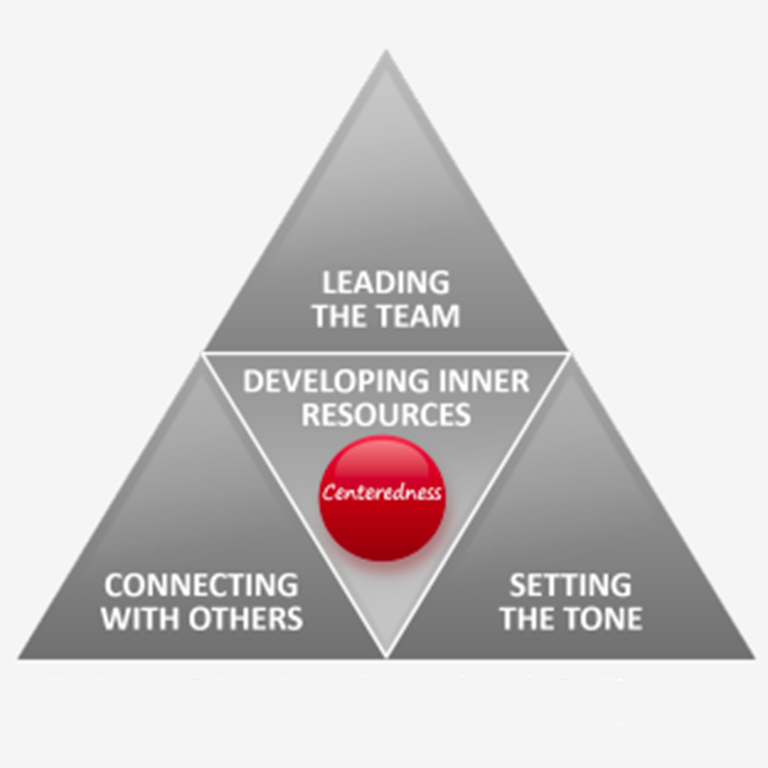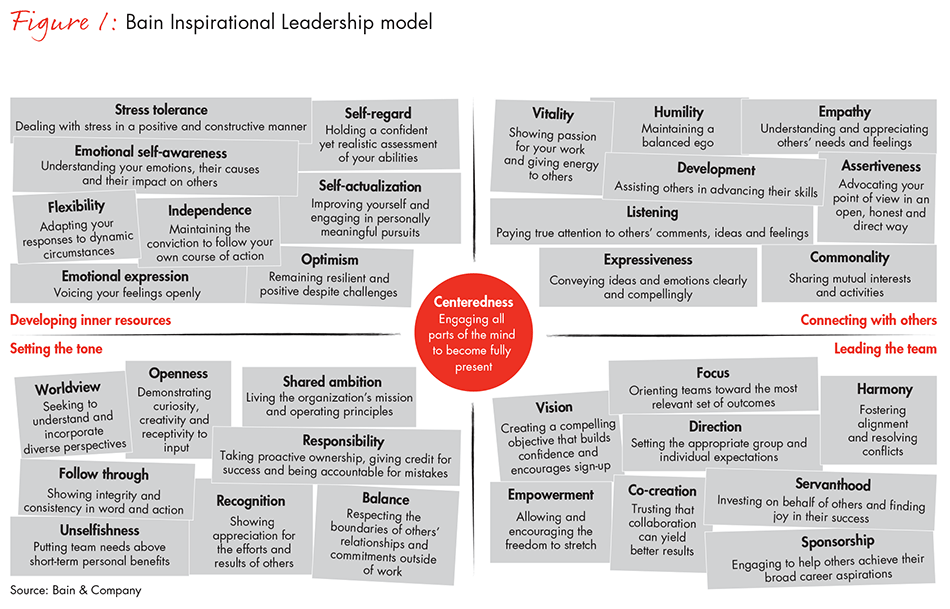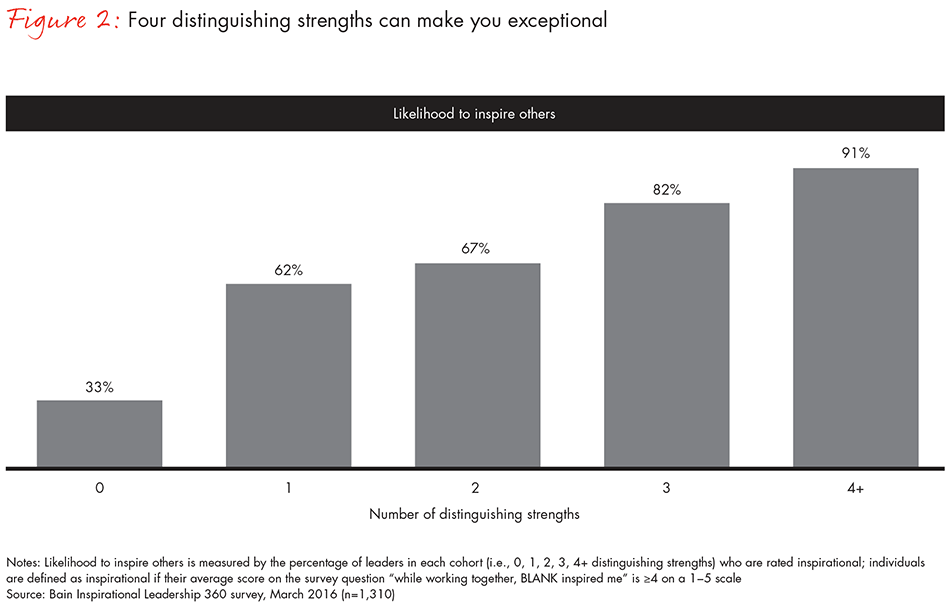Brief

What makes a leader inspiring? Companies that can answer this question have a powerful tool to increase their competitive edge. Inspired employees are more than twice as productive as satisfied employees, according to research Bain recently conducted with the Economist Intelligence Unit.
The power of a company with leaders who inspire at every level up and down the organization is hard to overstate. These are the companies that consistently pull off innovative or heroic feats in business because so many of the people who work there are motivated to make them happen. Companies spend billions of dollars on leadership training to reinforce and enhance the soft skills that inspire, motivate and create engagement, but most have found that it is deceptively hard to do these things.
Few rigorous methods exist to measure someone’s ability to inspire, to systematically develop that intangible quality or to embed those skills throughout an organization. As Barbara Kellerman, founding executive director of the Center for Public Leadership at the Harvard Kennedy School, has observed: "Leadership as an area of intellectual inquiry remains thin, and little original thought has been given to what leader learning in the second decade of the 21st century should look like."
What does it take to foster inspiring leaders, not just through a lucky accident of talent management but year in and year out? To help answer that question, we have been conducting comprehensive research since 2013, using Bain and select clients as a test bed. Specifically, we designed an analytical approach to define, measure and develop inspirational skills. Three key questions guided our research:
- What characteristics matter when it comes to inspiring others?
- How many inspiring behaviors does someone need to demonstrate reliably in order to inspire others, and what pattern of behaviors is most powerful?
- How can we calibrate the strength of those characteristics in an individual?
While inspiration may seem difficult to decipher, we identified 33 distinct and tangible attributes that are statistically significant in creating inspiration in others. And having just four of those attributes as distinguishing strengths is sufficient to make someone highly inspiring. The findings also demonstrate that people who inspire are incredibly diverse. Any combination of distinguishing strengths works: There is no fixed archetype of an inspirational leader.

What Do Employees Find Inspirational?
The Bain Inspirational Leadership System is made up of 33 elements we have identified as statistically significant for inspiring others.
The characteristics that matter
To understand what inspires people, we surveyed all employees, not just formal leaders or HR experts. Why? People at all levels of an organization seek inspiration. Employees can judge best what inspires them. It’s the collective voice of all those customers or followers that matters in validating which characteristics are inspiring, not what leaders say they do or what human resources managers assert is important.
Because inspiration is subjective, it helps to understand the basic shape of the analysis. Starting with an initial survey of 2,000 Bain employees, we asked respondents to rate how inspired they were by their colleagues. We also asked them to rate what was important in contributing to that sense of inspiration. To do this, we selected a list of attributes to test based on data gathered from multiple disciplines—including psychology, neurology, sociology, organizational behavior and management science—as well as extensive interviews.
Using followers’ responses, we conducted a conjoint analysis (typical in consumer research) to assess the relevance of a range of attributes contributing to respondents’ feelings of inspiration. The result was a set of 33 characteristics that are statistically significant in inspiring others. Bain then used this set of behaviors to create the Bain Inspirational Leadership model (see Figure 1).

These 33 characteristics that inspire vary widely. Self-regard, for example, is holding a confident yet realistic assessment of one’s abilities; expressiveness is conveying ideas and emotions clearly and compellingly; and empowerment is allowing and encouraging the freedom to stretch. Other attributes may also inspire, but collectively, the 33 behaviors we identified were the most powerful in contributing to inspiration.
We grouped the characteristics that inspire into four quadrants that highlight the setting in which they tend to apply. One quadrant, for example, contains the qualities related to leading a team. Another cluster includes behaviors that develop one’s inner resources, such as stress tolerance, optimism and emotional self-awareness. While these quadrants provide a structure that makes the model easier to digest, they do not emphasize any particular distribution of abilities. Our research demonstrates that each of the elements is important to the collective inspirational health of an organization and that no combination is more powerful in contributing to an individual’s capacity to inspire. It’s not necessary to have one attribute from each quadrant to be effective.
One surprising result: Centeredness was the most important attribute. Of all the elements, centeredness was the skill that employees most wanted to develop. Centeredness is a state of greater mindfulness, achieved by engaging all parts of the mind to be fully present. While a growing number of companies offer optional mindfulness programs to promote health and workplace satisfaction, our research shows that centeredness is fundamental to the ability to lead. It improves one’s ability to stay level-headed, cope with stress, empathize with others and listen more deeply.
Centeredness is the nexus of the other 32 elements and a mandatory skill. Just as leaders need to be able to meet their performance objectives to be rated as satisfactory, for example, we recognize that leaders need to be able to stay centered to inspire. Being centered is a precondition to using one’s leadership strengths effectively.
The most powerful combination
How many of these inspiring behaviors does someone need to reliably inspire others? We used our database of more than 10,000 assessments to correlate the profile of strengths and weaknesses with the level of inspiration stated by an individual’s colleagues.
We defined an individual’s distinguishing strengths as those that rank within the top 10% of one’s peer group. We labeled the characteristics ranked between the 70th and 90th percentiles as potential distinguishing strengths and those in the bottom 10% as weaknesses. The characteristics falling between the 10th and 70th percentiles are neutral characteristics, because one’s level of skill neither detracts from nor contributes to the differential effect on others.
The result was exciting: Even one distinguishing strength nearly doubles your chances of being inspiring—and the more distinguishing strengths you have, the more inspirational you can be. In fact, more than 90% of those demonstrating distinguishing strengths on four or more of the 32 elements are inspirational to their colleagues (see Figure 2). That finding underscores the power of authenticity: No combination of strengths is statistically more powerful than any other. Inspirational leaders come in many varieties.

The key developmental insight from these findings is that an individual can increase his or her inspirational leadership ability by excelling at just a handful of intrinsic strengths and converting weaknesses to neutral. The data also shows that it’s more effective to develop a distinguishing strength than to neutralize a weakness: On average, investing in adding a distinguishing strength is one and a half times more powerful at building inspiration than neutralizing a weakness.
Calibrating a strength
Why create a leadership program focused overwhelmingly on strengths? A growing body of research has shown that encouraging people to bolster their strengths is more effective than striving to fix their weaknesses. According to Gallup research, the odds of employees being engaged are 73% when an organization’s leadership focuses on the strengths of its employees vs. 9% when they do not.
"One of the things we know is that when things are negative, people see fewer options, [and] they’re less able to problem solve. It shuts down the brain," said business psychologist Jennifer Thompson, an associate professor at the Chicago School of Professional Psychology. "When people have positive environments, they’re more creative. They’re more productive."
Since inspiration is relevant to every employee, calibrating an individual’s strengths requires feedback from above, below and across the organization. To rate a person’s strength on a given attribute, we developed a 360-degree assessment based on the views of coworkers at every level. This customer input is then compared with an individual’s peers’ results to figure out his or her relative strength. Understanding where one stands out from the pack based on distinguishing strengths helps each individual define his or her leadership brand and use it more effectively in daily interactions.
Anyone can start developing the ability to inspire by discovering and cultivating his or her inherent talents. Bain’s Inspirational Leadership System includes structured reflection, input from 360-degree surveys and self-assessments. Each employee selects four or five characteristics out of the 32 based on their existing strengths and what feels authentic. That combination of skills becomes one’s "rock pile," or inspirational leadership brand—something each person can target for personal development and use on a daily basis.

How To Be an Inspirational Leader
Bain research identified 33 distinguishing characteristics of inspirational leaders. Having any four strengths can make you exceptional.
Building an organization that inspires
Typical leadership programs target a limited number of people within an organization—the traditional constituencies of senior executives and high potentials. Those who are excluded, including the vast majority of employees, never get a chance to develop their skills. But to function as a true system and build inspiration into an organization’s ways of working, leadership programs need to reach deeper. And the sooner people get started, the stronger and more valuable their skills will be as they rise in the organization.
The majority of our employees use Bain’s Inspirational Leadership System, and the goal is to reach every employee. The number of colleagues cited as inspirational grew by 18% between 2014 and 2015, and their influence is spreading: The percentage of employees who describe themselves as "inspired" has grown since the start of the program, along with corresponding measures of employee engagement and the strength of Bain’s culture, according to Bain’s Net Promoter System®.
Of course, Bain is not alone in its quest to understand what sets inspiring leaders apart. Many companies are experimenting with programs of their own. Aetna, for example, has implemented a companywide focus on mindfulness, sponsored by its CEO. And Telefonica Germany has launched empathy training for its employees in an effort to improve customer satisfaction. These types of programs are valuable, but many stop short of achieving their full potential. Our research shows a more comprehensive, analytical approach can create a powerful system that increases inspiration throughout an organization.
As the nature of work grows increasingly collaborative and self-directed, inspiration can make the difference between teams that outperform and those that lag. Leadership systems that systematically build inspiration work because, at their essence, they honor the complexity of human relationships, foster authenticity and create a common platform for every individual to make unique contributions. Companies that tap into that powerful combination will gain a competitive advantage that few can match.
Net Promoter System® is a registered trademark of Bain & Company, Inc., Fred Reichheld and Satmetrix Systems, Inc.
Mark Horwitch is a partner with Bain & Company, and he directs Bain’s leadership programs. Meredith Whipple Callahan is a senior manager with Bain’s leadership group. They are both based in San Francisco.
The authors would like to thank Vanessa William, a manager with the group, for her valuable contribution to this article.

